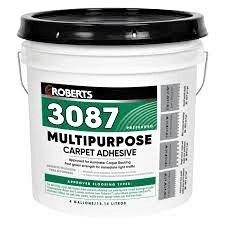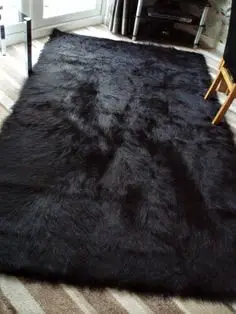When it comes to flooring, there are a lot of different options out there. But if you’re looking for something that’s both comfortable and stylish, carpet is the way to go.
If you’re also looking to add a touch of warmth and comfort to your home, look no further than installed carpet. Not only does it create a cozier feel, but it can also help reduce noise levels and make your home more energy-efficient. Installation is easy and only takes a few hours, so there’s no excuse not to add this home improvement project to your list!
And contrary to popular belief, installing carpet on concrete is actually relatively easy.
How to Install Carpet on Concrete Easily
I will help you to do this in an easy step-by-step guide.
Why install carpet on concrete?
Before we can start the process of installation why would you need to install a carpet on a concrete basement or floor.
There are many reasons to install carpet, including the following:
1. Carpet is comfortable and soft underfoot. There’s nothing quite like the feeling of soft, plush carpet under your feet. It’s one of the reasons why people love to have carpet in their homes. Carpet is comfortable and soft underfoot, making it a great choice for bedrooms, living rooms, and other areas where you want to relax and feel cozy.
2. Carpet is an effective insulator. Carpeting is made of materials that are good at trapping air. This helps to create a buffer between the floor and the rest of the room. This buffer can help to keep the temperature in the room more consistent. In addition, carpets can help to absorb sound waves. This can make a room feel quieter and more serene.
3. Carpet can help reduce noise levels, making it ideal for offices, schools, and other places where you need to concentrate.
4. Carpet is available in a wide variety of colors and styles to suit any taste or budget. When choosing the perfect carpet for your home, the options are endless. Carpet is available in a wide variety of colors and styles to suit any taste or budget. From classic neutrals to bold statement hues, there is a carpet color to complement every decorating style. If you’re looking for a durable and affordable flooring option, carpet is an excellent choice.
5. Carpet is also durable and easy to care for, making it a great flooring option for busy households. And with so many colors and styles to choose from, it’s easy to find the perfect carpet for your space. The carpet is also made from synthetic or natural fibers that are tightly woven together, making it resistant to wear and tear. It is also stain-resistant and easy to clean, making it a low-maintenance option for busy households
Recommended for you: Is Carpet Bad For Your Health? Harmful Gases Produced By Carpet
Tools and materials required in the installation of carpet on concrete
1. Measuring Tape – In order to ensure that your carpet is cut to the correct size, you will need good-quality measuring tape.

2. Utility Knife – This will be used to cut the carpet to size.

3. Hammer – You will need a hammer in order to affix the tackless strips around the perimeter of the room.

4. Chalk Line – A chalk line is used to mark where the tackless strips should be placed.
5. Tackless Strips – These are necessary in order to keep the carpet in place and prevent it from shifting or bunching up.
6. Staple Gun – A staple gun is used to attach the carpet padding to the floor.
4. Carpet adhesive – This is used to adhere the carpet to the concrete floor.

5. A roller – This is used to apply pressure to the adhesive and help bond it to the flooring surface.
6. Carpet to be installed.
7. Concrete nails.
8. Pad
Steps To Install Carpet on Concrete
Step 1: Measure the Space
Before you can start installing your new carpet, you’ll need to take some measurements. This is important in order to make sure that you have enough carpet to cover the entire area. To measure the space, start by measuring the length and width of the room. Then, add an extra 10 inches to each measurement. This will give you enough material to work with during installation.

Step 2: Choose the Right Type of Carpet
After measuring the carpet size, you need it’s time to purchase. Before you can purchase one you need to choose the type of carpet you need to install.
There are two main types of carpet that can be used on concrete: glue-down and floating. Glue-down carpet is attached directly to the concrete with an adhesive while the floating carpet is not attached to anything and simply rests on top of the floor.

Each type of installation has its own advantages and disadvantages, so it’s important to choose the one that’s right for your needs. Glue-down carpet is usually more durable and easier to clean, but it can be more difficult to install.
Factors to Consider When Choosing the Carpet
When choosing carpet to install on concrete, there are several factors you need to keep in mind.
The first is the thickness of the carpet. You need to make sure that the carpet is thick enough to withstand foot traffic without showing wear and tear.
The second factor is the type of backing. Some carpets have a backing that is not meant to be installed on concrete, so you need to make sure you get the right kind of backing.
The third factor is the size of the room. You need to make sure that the carpet you choose is big enough to fit the room you are putting it in.
Cost is also another factor. The cost of the carpet you choose to install should be within your budget.
See Also Is Carpet cheaper than Laminate?
Step 3: Prepare the Concrete Surface
Preparation is key when it comes to installing carpet on concrete. The first step is to clean the surface thoroughly. Any dirt, grease, or other contaminants will make it harder for the carpet to adhere.

Next, you’ll want to check for any cracks or unevenness in the concrete. These can be repaired with a patching compound before you begin laying down the carpet.
Once the surface is prepared, the next step is to install a vapor barrier. This will protect the carpet from moisture that can seep up from the concrete.
Step 4 Marking Line for the Strips
Fortunately, marking the line for your strips is relatively simple. Just follow these steps:
1. First, lay out all of your strips in their intended order. This will give you a better idea of how they should fit together.
2. Once you have an idea of the layout, take a chalk line and mark the edges of each strip.
Step 5 Install the Strips
Hammer the strips using concrete nails at the perimeter of the carpet. This can be done by following the marked lines. Ensure to drive the nails fully on the concrete.
Step 6 Lay Pad on the Concrete
A pad will help to protect your carpet from wear and tear. Carpet that is installed on bare concrete can be subject to a lot of wear and tear. A pad will help to extend the life of your carpet by protecting it from the everyday wear and tear that can occur on concrete floors.

A pad will also help to keep your carpets looking new for longer. Carpets that are installed on bare concrete can start to look worn and dingy over time.
Roll of the pad and trim its ends using a utility knife.
Step 7: Lay Down the Carpet
Apply carpet adhesive before you can start to lay down carpet.

Once the adhesive has been applied, you can start to lay down the carpet. It is important to start in one corner and work your way out. This will help to ensure that the carpet is laid evenly and there are no gaps.
If you need to make a join, use a seamer
Here’s a step-by-step guide to joining your carpets using a seamer:
1. Start by laying the two pieces of carpet next to each other, ensuring the edges are aligned.
2. Place the seaming iron on top of the seam tape and heat it up.
3. Once the seaming iron is hot, press it down onto the seam tape, melting it and bonding the two pieces of carpet together.
4. Run your fingers along the seam to make sure that it’s smooth and even.
Once the carpet has been laid, you can trim any excess off around the edges. You may also want to consider using a sealant or protector on the carpet to help extend its life.
Step 8: Roll on the carpet
Here’s why you should roll on the carpet during installation:
1. It helps to stretch the carpet and get rid of any wrinkles.
2. Rolling on the carpet gives you a better bond between the adhesive and the backing.
3. It allows you to evenly distribute the pressure, so you don’t end up with any lumps or bumps.
Step 9: Trim and secure the edges
Ensure to trim neatly carpet edges
If you don’t trim the edges of your carpet, they’ll start to fray over time. Not only does this look unsightly, it can also cause trip hazards.

Securely attaching the carpet to the floor will also help to prevent fraying and extend its lifespan. Plus, it’ll give your home a neat and tidy look.
Conclusion
After you’ve laid down the groundwork for your new carpeted space, it’s time to sit back and enjoy it. Here are a few tips on how to keep your carpet looking its best:
1. Vacuum regularly – at least once a week – to prevent dirt and debris from building up.
2. Spot clean spills as soon as they happen using a mild detergent and a damp cloth.
3. Have professional steam cleaning done every 6-12 months to deep clean the fibers and prolong the life of your carpet.
Now that you know how to keep your new space looking its best, enjoy it! Carpeted floors add an extra level of comfort and style to any home, and they’re much easier to care for than you may think.
Recommended: How to get out wrinkles of carpet without a stretcher?
FAQs
How do you connect carpet to concrete?
You can choose to use adhesive, tacks, or double-sided tape. The adhesive is the most permanent option, but it can be difficult to remove if you ever need to replace the carpet. Tacks are less permanent and can be removed more easily, but they may not hold as well. A double-sided tape is a temporary option that can be removed without damage, but it may not hold up as well over time.
Should a concrete floor be sealed before carpeting?
When it comes to protecting your concrete floor, sealing it before you carpet is always a good idea. Not only will it help your carpet last longer, but it will also protect your concrete from any spills or stains.
Sealing your concrete floor is a simple process that only takes a few minutes.
First, you’ll want to clean the floor thoroughly with a vacuum and mopping. Once the floor is clean, you can apply the sealant with a brush or roller. You’ll want to make sure you evenly coat the entire surface of the floor.
After the sealant has been applied, you can then lay down your carpeting. This will create an extra barrier between your concrete and any potential damage. By taking these simple steps, you can help protect your investment and keep your floors looking great for years to come.
Does carpet pad need to be glued down on concrete
Carpet pad is a necessary part of any carpet installation, but many people are unsure of whether or not it needs to be glued down on the concrete. The answer is that it depends on the type of carpet pad you are using. If you are using a foam carpet pad, then it is not necessary to glue it down.
However, if you are using a felt or fiberglass carpet pad, then you will need to glue it down in order to prevent it from shifting.


